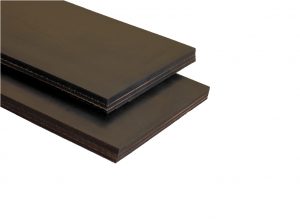
Conveyor Belting can become sheet rubber for gaskets, rubber bumper guards and edging, and even short large diameter hose. When we need to quote a sheet rubber application, we go to our sheet rubber and gasket material product lines. If we cannot find the right solution there, a little ingenuity and industry experience allows us to provide some less traditional options.
Conveyor belting is essentially a high tensile rubber or vinyl sheet, with heavy plies of reinforcement. More than a bit like our fabric reinforced rubber sheet products like “Cloth” Insert Neoprene sheet (which is old lingo for the reinforcement that now is primarily nylon or synthetic cord), conveyor belting can be used in a similar manner. Additionally, it can be easily ordered in slit widths from a few inches up to 3 or 4 feet wide. The heavy gauge reinforcement allows it to withstand pressures of being used as a pad for equipment, as a wall guard, or even in some large diameter sealing applications*.
Belting can also be made “endless” in that it can come as a regular flat roll or in finished loop form. With widths up to 4 feet wide, this means a 4 foot chute or connector can be made from belt in place of tubing or hose. Since the belting comes in very long lengths, this can be beneficial where a very large diameter but short length is needed. Because conveyor belting is designed to withstand the abuse of many dry abrasives, a short hose made from belting could also withstand sand and gravel chute applications where Elephant-Trunk hose is typically used.
*Care should be taken to ensure the tolerance of belting is sufficient vs traditional sheet rubber products. Durometer, cut widths, and manufactured thickness tolerances may be of issue in critical applications. While the tensile PSI rating is typically high for conveyor belting, since they are not designed for hose or tubing use, there would be no specific manufacturer’s recommended working pressure or burst rating.